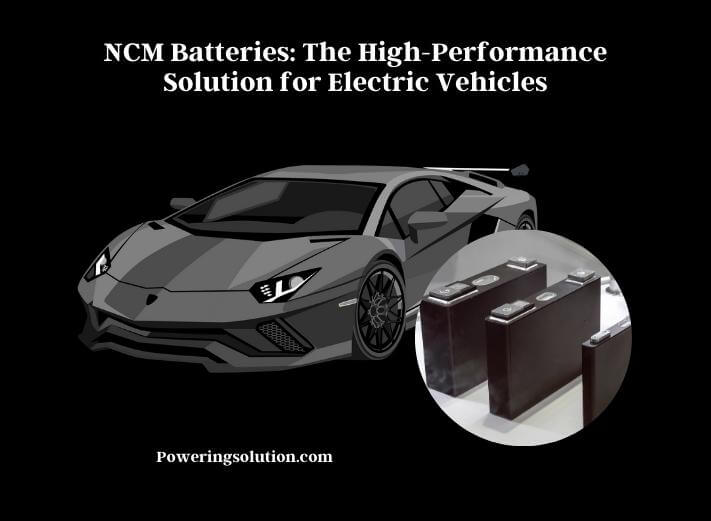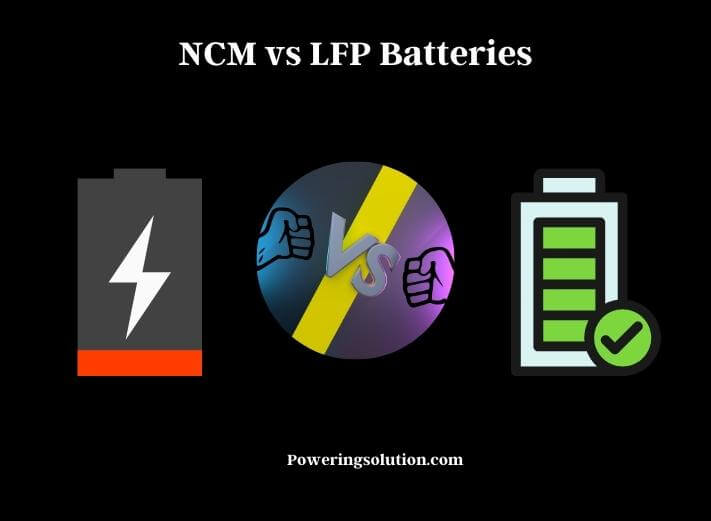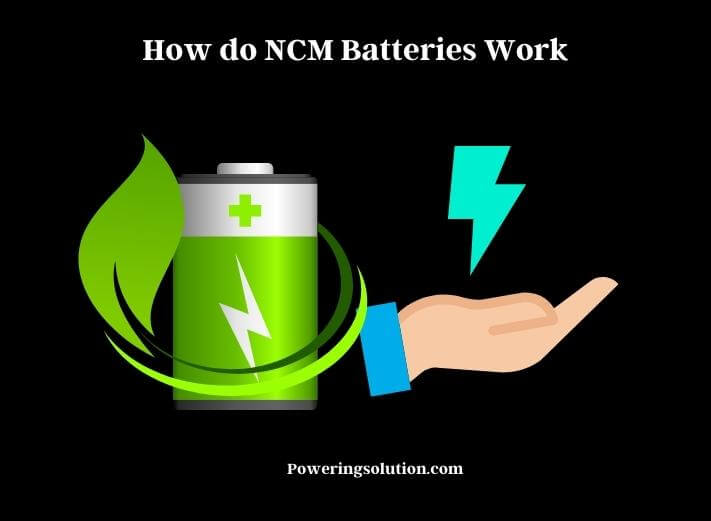NCM (Nickel Cobalt Manganese) batteries are a type of lithium-ion battery that is becoming increasingly popular in electric vehicles (EVs) due to their high energy density, longer lifespan, and faster charging time compared to other types of lithium-ion batteries. As the demand for EVs continues to grow, the demand for NCM batteries is also expected to increase.

What are NCM Batteries?
NCM batteries are a type of lithium-ion battery that consists of three key elements: Nickel (N), Cobalt (C), and Manganese (M). The ratio of these three elements in the battery determines its performance characteristics. NCM batteries can have varying ratios of N, C, and M, with the most common being NCM 111, NCM 523, and NCM 622. NCM batteries are known for their high energy density, fast charging capabilities, and long lifespan.
How do NCM Batteries Work?
NCM (Nickel Cobalt Manganese) batteries are a type of lithium-ion battery that works by storing energy in chemical form. The battery consists of three main components: the cathode, the anode, and the electrolyte.
The cathode is typically made up of a mixture of nickel, cobalt, and manganese, hence the name NCM. The anode is usually made of graphite or silicon, while the electrolyte is a liquid or gel substance that allows for the transfer of ions between the cathode and anode.
When the battery is charged, lithium ions move from the cathode to the anode, where they are stored. During discharge, the lithium ions move back to the cathode, releasing energy in the process. The chemical reactions involved in this process are reversible, allowing the battery to be charged and discharged multiple times.

NCM batteries have a higher energy density compared to other types of lithium-ion batteries due to the combination of nickel, cobalt, and manganese in the cathode. This allows for greater storage of energy in a smaller space, making NCM batteries ideal for use in EVs where space is limited.
NCM batteries work by using the movement of lithium ions between the cathode and anode to store and release energy in chemical form, allowing for the efficient and reliable operation of electric vehicles.
Benefits of NCM Batteries
NCM (Nickel Cobalt Manganese) batteries offer several benefits compared to other types of lithium-ion batteries, making them an attractive solution for various applications. Some of the main benefits of NCM batteries include:
- NCM batteries have a higher energy density compared to other types of lithium-ion batteries, allowing them to store more energy in a smaller space. This makes them ideal for use in electric vehicles, where space is limited and a higher energy density means greater range.
- NCM batteries have a longer lifespan compared to other types of lithium-ion batteries, allowing them to be charged and discharged more times before needing to be replaced. This reduces the cost of ownership and makes them more sustainable.
- NCM batteries have a faster charging time compared to other types of lithium-ion batteries, allowing them to be charged more quickly. This is particularly useful for electric vehicles, where fast charging times are necessary to reduce downtime and increase usability.
- NCM batteries have improved safety compared to other types of lithium-ion batteries, as they are less prone to thermal runaway and overheating. This reduces the risk of fire or explosion, making them safer for use in various applications.
- NCM batteries are becoming increasingly cost-effective as production processes improve and demand increases. This makes them more accessible for use in various industries, including electric vehicles, consumer electronics, and renewable energy storage.
NCM vs LFP Batteries
Here is a table comparing NCM and LFP batteries:

| Point | NCM Batteries | LFP Batteries |
| Chemical Composition | Nickel-Cobalt-Manganese (NCM) | Lithium Iron Phosphate (LFP) |
| Energy Density | Higher energy density | Lower energy density |
| Voltage | Higher voltage | Lower voltage |
| Performance | Faster charging time and longer cycle life | Slower charging time and shorter cycle life |
| Cost | More expensive due to higher-quality raw materials | Less expensive due to lower-quality raw materials |
| Safety | Improved safety features, but still susceptible to overheating and fires | More stable and less likely to overheat or catch fire |
| Environmental Impact | More significant environmental impact due to the use of cobalt and nickel | Lower environmental impact due to the use of iron |
It is important to note that the choice between NCM and LFP batteries depends on the specific application and requirements. While NCM batteries offer higher energy density and faster charging times, LFP batteries may be more suitable for applications that require higher levels of safety and stability.
NCM Batteries and the Future of EVs
NCM (Nickel Cobalt Manganese) batteries are expected to play a significant role in the future of electric vehicles (EVs), as they offer a high-performance solution that can help overcome some of the main barriers to EV adoption.
NCM batteries have a higher energy density compared to other types of lithium-ion batteries, allowing them to store more energy in a smaller space. This means that EVs with NCM batteries can travel further on a single charge, making them more practical for long-distance driving.
NCM batteries have a faster charging time compared to other types of lithium-ion batteries, allowing them to be charged more quickly. This means that EVs with NCM batteries can be charged in a shorter amount of time, reducing downtime and increasing usability.
As production processes improve and demand increases, the cost of NCM batteries is expected to decrease, making them more accessible for use in EVs. This could help to reduce the overall cost of EVs, making them more affordable and accessible to a wider range of consumers.
NCM batteries have improved safety compared to other types of lithium-ion batteries, as they are less prone to thermal runaway and overheating. This makes them safer for use in EVs, reducing the risk of fire or explosion.
NCM batteries have a longer lifespan compared to other types of lithium-ion batteries, allowing them to be charged and discharged more times before needing to be replaced. This makes them more sustainable and reduces the environmental impact of EVs.
xZNCM batteries offer several advantages that could help to drive the adoption of EVs and shape the future of transportation. As technology continues to improve and production processes become more efficient, the use of NCM batteries is likely to become more widespread in the EV industry.
NCM Battery Market Outlook
The NCM battery market outlook looks promising, as demand for electric vehicles (EVs) continues to grow worldwide. According to a report by MarketsandMarkets, the global NCM battery market is expected to reach $9.1 billion by 2025, with a compound annual growth rate of 16.5%.
One of the key drivers of the NCM battery market is the increasing demand for EVs, particularly in China, Europe, and North America. As governments and consumers become more concerned about the environmental impact of fossil fuel vehicles, there is a growing interest in EVs as a cleaner and more sustainable alternative. NCM batteries, with their high performance and improved safety features, are well-suited for use in EVs and are expected to see a rise in demand as EV adoption continues to grow.
Another factor driving the NCM battery market is the increasing focus on renewable energy sources. NCM batteries can be used to store energy from renewable sources such as wind and solar power, allowing for more efficient and sustainable energy use.
Despite the positive outlook, the NCM battery market still faces some challenges. One of the main barriers is the high cost of production, particularly for the cobalt component of the battery. As demand for NCM batteries increases, there may also be concerns around the availability of raw materials such as cobalt and nickel.
Challenges and Limitations of NCM Batteries
While NCM batteries offer many benefits, they also face some challenges and limitations that must be considered.
One of the main challenges facing NCM batteries is the cost of production. NCM batteries require high-quality raw materials such as cobalt and nickel, which can be expensive to acquire. As demand for NCM batteries grows, the cost of these materials is likely to increase, which could make NCM batteries less cost-effective for certain applications.
Another challenge is the safety of NCM batteries. While NCM batteries have improved safety features compared to other types of batteries, they are still susceptible to overheating and fires if they are not properly manufactured or handled. This can be a concern for EV manufacturers and users, who rely on the safety of their batteries for reliable and safe operation.
NCM batteries also have some limitations in terms of their energy density and overall performance. While NCM batteries offer higher energy density than other types of batteries, such as lead-acid batteries, they still have lower energy density compared to other emerging battery technologies such as solid-state batteries. This means that NCM batteries may not be suitable for all applications, particularly those that require high energy density or fast charging capabilities.
Finally, the environmental impact of NCM batteries must be considered. The production and disposal of NCM batteries can have a significant environmental impact, particularly due to the use of raw materials such as cobalt and nickel. This has led to concerns around the sustainability of NCM batteries, and there is ongoing research and development focused on improving the environmental impact of battery production and disposal.
Final Thoughts
NCM batteries have emerged as a high-performance solution for electric vehicles and renewable energy storage systems. With their higher energy density, faster charging times, and longer cycle life, NCM batteries offer significant advantages over other types of batteries.
NCM batteries have already become widely used in the EV market, powering many popular electric vehicle models. As the demand for electric vehicles and renewable energy storage systems continues to grow, the market for NCM batteries is expected to expand significantly in the coming years.
NCM batteries also face some challenges and limitations that must be addressed in order to ensure their continued success in the market. The cost of production, safety concerns, and environmental impact are all important factors that must be considered when evaluating the suitability of NCM batteries for a specific application.
If you want to about Voltage Regulators, see here for details.
